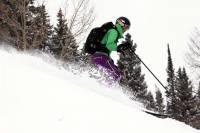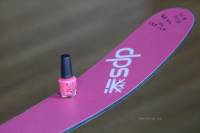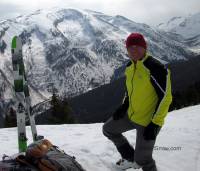While most published ski tests are done at resorts and emphasize the down, we go mostly human powered and emphasize weight, width and even topskin color when we make our “editor’s choice” picks. This year I’m continuing my bias to lighter weight. Our testing indicates the propeller heads in their resin filled workshops have indeed figured out additional tricks to squeeze more performance from less mass.
To do our evaluations we use an informal system of gathering impressions from various testers. Most of the skis make a trip through WildSnow HQ. Lisa and I and our son Louie ski on many, and we lend nearly everything out to folks of various ages, genders and styles. I acquire varied opinions on everything and make the final pick based on this season’s biases. Please know that we make no effort whatsoever to evaluate every ski on the market. We cream-skim from the start, and especially in the case of new product lines we may entirely ignore something with the intent of giving it time to mature in the retail world.
Regarding weight vs performance on the down, It’s true that sometimes better downhill ski performance is achieved by heavier skis. BUT a “heavier” ski doesn’t ski better just because of mass. Often it simply skis better because allowing more mass gives engineers more freedom with material mixes. The lighter the ski, the less material you’re allowed, and your choice of materials becomes more limited. Thus, how a ski turns is about how well it’s designed, not that it’s lighter or heavier. What puts the lie to the “it’s heavier so it skis better, it busts through crud!” myth is that all skis have become lighter over the years. If they skied better heavier, they would have stayed heavier. Think of it this way, a lightweight ski today will be normal in a few years — will the norm of the future ski worse than today’s? Not a chance.
This year, for fun I’ve loosely ordered the skis according to their weight/surface scores. Caveat about that: WildSnow has been influential over the past few years in showing how serious the ski touring public is about hauling lighter weight gear. Ski companies have followed suit and engaged in somewhat of a weight war. All is fair in war, including gram saving tricks such as using less steel edge at tip and tail, providing smaller less beefy binding mount areas, and the most heinous trick of them all: molding depressions and hollows in the top surface that eliminate mass in the factory but encourage ice and snow buildup in real-world use. Thus, don’t nuke your credit card for the absolute lightest ski until you’re sure those sorts of “features” are okay for your intended use.
La Sportiva Vapor Nano
130/103/120
If a ski wins our weight/surface calculations it probably has to reside in the Ultimate Quiver. Nano is that. Obviously optimized as a soft snow ski, Nano is survivable on hardpack. In my opinion this is the “ultimate” powder farmer since it gives you optimal width at the least mass, with snap when you want it but some capability to slarve and “soft rail” as well. Lack of steel edges at tip and tail could be a concern, and the binding mount area is of minimal beef so careful installation of bindings is essential. With a full season of retail distribution we’ve not heard of any significant durability issues, but anecdotal evidence says this is an average strength ski, not burly, and should be treated as such. (2014-2015 model has added strength in the tip, not sure how much weight that’ll add, if any. We’ll update here when they reach our scale.)
(Dedicated cut skins are available for La Sportiva skis, sourced from Pomoca. Sportiva says they’re the 70% mohair, 30% nylon blend. We found them to be adequate but average; difficult to ascertain exactly which Pomoca variety is used as they sell several different type skins with 70/30 mix, but they’re the same yellow as the Pomoca “Climb” model.)
Ski Trab Magico
116/83/104 (171 cm)
Yes, our Ultimate Quiver reviews are usually biased to soft natural snow. But what about a ski for spring corn and steep couloirs, and situations where saving weight is of über importance?
Enter the Ski Trab Magico. At exactly a kilo per plank in a 171 cm, Magico indeed hits the magic goal of the “one kilo ski,” and does it well. (Make no mistake, these guys are light! Magico scores as numero uno in our weight/length ratings, and third in our weight/surface ratings.)
We had four experienced skiers test Magico. All raved about the edge hold and lively nature of this ski. We agreed it wasn’t the wide and rockered powder guppy we’ve come to want in our quiver, what with no rocker and an 81 mm footprint. But 81 mm will still feel okay in the polvo, while saving weight and giving that narrower knife-like cut on harder snow. I’d recommend this as a quiver of one for the ski tourer who likes a trad ride, but for most of us it is a more specialized tool.
(Dedicated pre-cut skins are available for all Trab skis. We’ve found these skins to be quite nice, very European in that they glide well and the glue isn’t too sticky.)
Read our Ski Trab Magico review.
Dynafit Cho Oyu
124/88/110 (174 cm)
These boards are designed in Germany, so I shouldn’t call them the Swiss Army Knife of ski touring — but I will anyway. Slice it, dice it, pound it, carve it — about all the “Choodie” won’t do is slarve it. Incredibly light, good edge hold, bouncy and snappy in pow (so 1980s, but so fun.) Cho Oyu is definitely a quiver of one for the traveling ski tourer who isn’t hitting the big pow destinations.
These are a carryover from last year’s Ultimate Quiver so I won’t go into detail. Though it’s worth mentioning they’re almost a one kilo ski at 1,183 grams for the 174 centimeter version. Honorable mention also goes to Dynafit Denali, but we felt it to be a more demanding ski than some of the others in similar weight class, so went with Choodie for the Quiver.
(Dedicated pre-cut “Speedskin” climbing skins are available for all Dynafit skis. These are sourced from Pomoca and we like their grip and glide. Confusion arises because Pomoca provides two types of glue, the North American version is sticky, but too sticky for our taste. We’re not sure what type of glue the Speedskins imported to North America will have, so we’re checking on it.)
Black Diamond Carbon Convert
133/105/117

Black Diamond Carbon Convert is a winner. Only downside is a bit of an ice and snow catching duck pond at the tip, but the white color compensates.
I was amused last winter when one of the Black Diamond product engineers asked me outright for my weight/surface formula — and said they were designing with the math in mind so they’d end up at the top of the chart. That’s mostly good (and they even found a small mistake in my calcs, thankyouverymuch). Nonetheless, what concerned me is the possibility of compromising something like durability or how far the ski edges run to tip and tail, just so the ski can look good in a list.
After a winter of testing, the C-Convert has proven to be adequate in the durability department, though it does have the edgeless tip and tail that many of the super-lightweights are sporting.
Up to you. If you do much Davenporting (rock skiing with minimal snow) you’ll chunk Ptex off the tips and tails — while in normal use that’s a non issue. Make no mistake, with a 105mm waist this plank is on the edge of being too fat for many committed human powered skiers. But with the weight savings of carbon, you can get away with it. Sadly, the Convert tip area has a top surface profile that holds snow, but the white color compensates for that somewhat. Works on hardpack, but as with most of our quiver skis we’d call this a soft snow plank.
Black Diamond Carbon Convert Review.
DPS Wailer 112 RP & Yvette, Pure3
141/112/128
I was tempted to make the famed Wailer 99 Pure2 and Pure3 a perennial here but why repeat what you can read about in last years Ultimate ski review? Instead, I thought it better to feature the wider Wailer 112, the plank my wife Lisa says changed her life.
Wailer 112 and Yvette are both the same construction. Yvette is the “women’s” version with a different color and probably a different mounting position (though the mounting marks seem to have varied a bit according to exactly which year’s manufacturing you’re buying skis from.) Main thing to remember about this is if you’re a woman you’ll probably want to be sure you’re in a slightly forward mount position on the Wailer, +1 as it’s marked, and possibly forward on the Yvette as well. Find more discussion about that in Lisa’s reviews of the 112s.
Know that Wailer 112 Pure3 falls in the sweet spot on our weight chart, skis fantastically in nearly any snow conditions (it’s not for blue ice in couloirs, sorry), and of course shows the world that you are part of the Drakeonian cult (know the secret handshake?). Our only complaint is that the twin-tip tail could be slightly bobbed, trimming some weight and making the ski that much easier to jab in the snow or haul on a backpack.
Note that our take here is the Wailer 112RP. For this coming season they’ve done some small design tweaks and are calling the new version Wailer 112RP2. Frankly, we’re thinking anything they did to this ski was mostly for factory fun (as in, it’s getting boring around here…), rather than making any real world improvement in how they ski. My take: Purchase either version and you’ll be happy. Also, as far as we could glean the Yvette remains the same ski as the Wailer, only a different color with a shifted mount point. Caveat: If you end up looking to acquire the RP2 version, check the weight on a scale and make sure it’s in the ballpark with the former version as detailed in our reviews. Skis gain weight from year to year, just like people.
Lisa’s review of Wailer 112 RP and Yvette.
Shop for DPS skis.
K2 Talkback & Wayback 96
128/96/118
We’re pretty sure the Wayback 96 and Talkback 96 are the same ski, with different graphics and perhaps a slightly different women’s mounting position on the Talkback. If we’re wrong, I promise I’ll watch the Mono Lake sequence from Doctor Strange Glove 16 times in a row, as well as sleeping with every K2 ski we own for three weeks. How is that for a confident ski journalist?
In any case, just as our promise above goes to the dark recesses of ski history, heritage of the Wayback goes way back to a 2009 vintage ski called the Baker Superlight, which was in turn parented by the popular all conditions Mount Baker. This is strong lineage. Along the way, Wayback grew in width and gained more rocker, to become a modern powder slayer that also delights on the hardpan. In other words, this is indeed a ski you could travel with as a quiver of one. (Original Baker was 122/86/107 mm, this season’s Wayback is 128/96/118).
Honorable mention goes to K2 Coomback and Gotback. These planks have the heritage as well and ski strongly, yet they’ve always been a bit on the heavy side. Latest versions have been lightened up a bit, so worth looking at. We’ll be doing more extensive testing this winter.
(Dedicated pre-cut climbing skins are available for all skis in the K2 “Backside” product line. We’ve found these skins to be adequate, but lacking in glide.)
Review of Wayback & Talkback skis
Shop for K2 Wayback & Talkback
G3 ZenOxide C3 (2014/15, ZenOxide Carbon 105)
131/105/123

Tester says: I've been skiing a test pair of ski's with white graphics. It's surprising how much less snow sticks to a white, sun-reflecting top sheet.
I almost didn’t include ZenOxide in the Quiver. That is until one tester I ultra respect told me they “ripped.” Why not give honors? Why not include? Remember my rant above about tricky stuff to lighten up skis so the weights look good in print? G3 molds a thinner section in the center of tip and tail, thus creating a duck pond for water and ice to collect in. This might seem terribly nerdish, but on a narrower pair of G3 Synapse Carbon 101s I filled the ponds with water and weighed. Result, 44 grams or more depending on how much sticky wet snow accumulated (the water ponds I made were small.) So where does that 44 or more grams take the Synapse 101 on the weight chart? Quite a ways down. Highly disappointing. I’m thus assuming that ice and snow ponding on the ZenOxide would be equally annoying and move it several steps down on the weight chart.
Yeah, G3 Zenoxide C3 rips. Moreover, I didn’t want to get turned away at the Canadian border for lack of Canadian loyalty. But please guys, could you make them a more heat reflective color and get rid of the swimming pools?
Summary from review and testing Zenoxide C3: Stiff and demanding, but powerful. For the expert skier who can deal with high energy levels. Early rise tip and no significant rocker.
(G3 makes two versions of their popular nylon climbing skins. Alpinist is the best gliding of any nylon skin we’ve used, but they lack traction. High Traction version climbs better and only sacrifices a bit of glide.)
Check out our G3 Zen Oxide C3 review
Shop for ZenOxide
Voile V8
141/112/123 (176 cm)
Everything about these Voile powder engines screams ride me. From the wood core feel to the reasonable weight, they rock. What’s not to love? The tail really doesn’t need to be a tip. Cut that down and the weight would be even more competitive. Even so, V8 falls in a good spot on our weight chart. These are a carry-over from last year’s quiver. Couldn’t help it. Amazingly affordable and they’re made in the U.S.A. Graphics are new this year but the V8 still fires on all cylinders.
Shop for Voile V8 ski touring skis
Volkl BMT 109
134/109/119 (109 version, quiver pick)
122/94/112 (94 version, honorable mention)
These guys fall in the middle of our weight/surface chart, which is good for a hard charging ski that’s comfortable both on and off the resort. I included here as a ski for the mucho agro.
Reviewer Joe Risi: “Straight over and through boot high moguls at semi-mach schnell speed we went. The BMT 109s barely shrugged in their presence assuring me they aren’t only for “Big Mountain Touring,” as they’re name suggests. In terms of backcountry natural snow performance, excelling in wind drifts and untracked boot high powder caused my confidence in the BMT’s to grow.”
Prize for “Best Looking Ski of the Year” from Sleight of Hand Publishing, this black on black ski also wins the prize for the ski most likely to develop an arctic ice sheet on top. But can she ski? Yes indeed.
If the BMT 109 sounds like too big a ski, let me give honorable mention to BMT 94. Actually, it was a tossup which BMT we’d include in the quiver. In Chile this past September I spent four days testing the 94 and was amazed at how solid and easy turning they were in less than ideal snow. They also held on some ice that we could have used for cubes to cool our pisco sour. Only issue with either of these planks is you’ve got the proverbial “climate change” black topskin that does a good job of creating sticky snow and ice you’ll have to lug around. As consolation, at least the topskin shape is raised in the middle and tapered towards the edges, unlike some of the other annoying “duck pond” configurations you’ll find with other brands.
(Dedicated climbing skins are available for BMT skis; they utilize the keyhole shaped hole in the tip. I found these to be fiddly during removal due to the need to rotate the skin tip to remove the anchor from the hole. Source brand is Kohla, a skin from Austria that’s said to use a “vacuum” adhesion that differs quite a bit from other “glueless” skins. We looked at these while at ISPO last winter; testing will commence.)
Shop for V-Werks BMT skis by Volkl.
Ultimate Quiver 2013-2014
Ultimate Quiver 2012-2013
WildSnow.com publisher emeritus and founder Lou (Louis Dawson) has a 50+ years career in climbing, backcountry skiing and ski mountaineering. He was the first person in history to ski down all 54 Colorado 14,000-foot peaks, has authored numerous books about about backcountry skiing, and has skied from the summit of Denali in Alaska, North America’s highest mountain.








